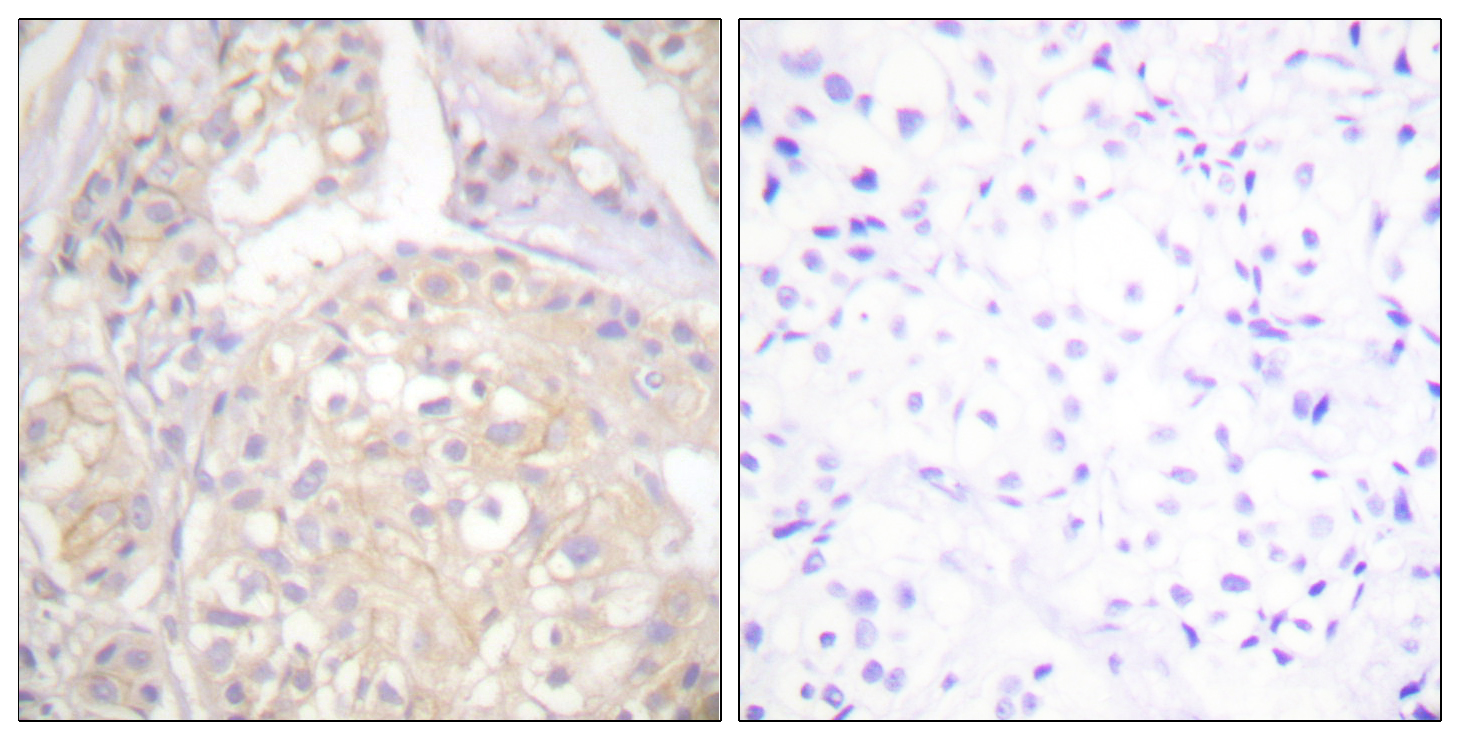Phospho FGFR1 (Y766) Cell-Based Colorimetric ELISA Kit
- 货号:KA1282C
- 应用:ELISA
- 种属:Human;Mouse;Rat
- 基因名称:
- FGFR1 BFGFR CEK FGFBR FLG FLT2 HBGFR
- Human Gene Id:
- 2260
- Human Swiss Prot No:
- P11362
- Mouse Swiss Prot No:
- P16092
- Rat Swiss Prot No:
- Q04589
- 储存:
- 2-8°C/6 months
- 其他名称:
- Fibroblast growth factor receptor 1 (FGFR-1) (EC 2.7.10.1) (Basic fibroblast growth factor receptor 1) (BFGFR) (bFGF-R-1) (Fms-like tyrosine kinase 2) (FLT-2) (N-sam) (Proto-oncogene c-Fgr) (CD antigen CD331)
- 检测方法:
- Colorimetric
- 背景:
- catalytic activity:ATP + a [protein]-L-tyrosine = ADP + a [protein]-L-tyrosine phosphate.,disease:A chromosomal aberration involving FGFR1 may be a cause of stem cell leukemia lymphoma syndrome (SCLL). Translocation t(8;13)(p11;q12) with ZMYM2. SCLL usually presents as lymphoblastic lymphoma in association with a myeloproliferative disorder, often accompanied by pronounced peripheral eosinophilia and/or prominent eosinophilic infiltrates in the affected bone marrow.,disease:A chromosomal aberration involving FGFR1 may be a cause of stem cell myeloproliferative disorder (MPD). Translocation t(6;8)(q27;p11) with FGFR1OP. Insertion ins(12;8)(p11;p11p22) with FGFR1OP2. MPD is characterized by myeloid hyperplasia, eosinophilia and T-cell or B-cell lymphoblastic lymphoma. In general it progresses to acute myeloid leukemia. The fusion proteins FGFR1OP2-FGFR1, FGFR1OP-FGFR1 or FGFR1-FGFR1OP may exhibit constitutive kinase activity and be responsible for the transforming activity.,disease:A chromosomal aberration involving FGFR1 may be a cause of stem cell myeloproliferative disorder (MPD). Translocation t(8;9)(p12;q33) with CEP110. MPD is characterized by myeloid hyperplasia, eosinophilia and T-cell or B-cell lymphoblastic lymphoma. In general it progresses to acute myeloid leukemia. The fusion protein CEP110-FGFR1 is found in the cytoplasm, exhibits constitutive kinase activity and may be responsible for the transforming activity.,disease:Defects in FGFR1 are a cause of idiopathic hypogonadotropic hypogonadism (IHH) [MIM:146110]. IHH is defined as a deficiency of the pituitary secretion of follicle-stimulating hormone and luteinizing hormone, which results in the impairment of pubertal maturation and of reproductive function.,disease:Defects in FGFR1 are a cause of Pfeiffer syndrome (PS) [MIM:101600]; also known as acrocephalosyndactyly type V (ACS5). PS is characterized by craniosynostosis (premature fusion of the skull sutures) with deviation and enlargement of the thumbs and great toes, brachymesophalangy, with phalangeal ankylosis and a varying degree of soft tissue syndactyly.,disease:Defects in FGFR1 are the cause of Kallmann syndrome type 2 (KAL2) [MIM:147950]; also known as hypogonadotropic hypogonadism and anosmia. Anosmia or hyposmia is related to the absence or hypoplasia of the olfactory bulbs and tracts. Hypogonadism is due to deficiency in gonadotropin-releasing hormone and probably results from a failure of embryonic migration of gonadotropin-releasing hormone-synthesizing neurons. In some cases, midline cranial anomalies (cleft lip/palate and imperfect fusion) are present and anosmia may be absent or inconspicuous.,disease:Defects in FGFR1 are the cause of non-syndromic trigonocephaly [MIM:190440]; also known as metopic craniosynostosis. The term trigonocephaly describes the typical keel-shaped deformation of the forehead resulting from premature fusion of the frontal suture. Trigonocephaly may occur also as a part of a syndrome.,disease:Defects in FGFR1 are the cause of osteoglophonic dysplasia (OGD) [MIM:166250]; also known as osteoglophonic dwarfism. OGD is characterized by craniosynostosis, prominent supraorbital ridge, and depressed nasal bridge, as well as by rhizomelic dwarfism and nonossifying bone lesions. Inheritance is autosomal dominant.,function:Receptor for basic fibroblast growth factor. A shorter form of the receptor could be a receptor for FGF1 (aFGF).,PTM:Binding of FGF1 and heparin promotes autophosphorylation on tyrosine residues and activation of the receptor.,similarity:Belongs to the protein kinase superfamily. Tyr protein kinase family.,similarity:Belongs to the protein kinase superfamily. Tyr protein kinase family. Fibroblast growth factor receptor subfamily.,similarity:Contains 1 protein kinase domain.,similarity:Contains 3 Ig-like C2-type (immunoglobulin-like) domains.,subunit:Interacts with SHB. Interacts with KLB.,
- 功能:
- MAPKKK cascade, skeletal system development, protein amino acid phosphorylation, phosphorus metabolic process,phosphate metabolic process, cell surface receptor linked signal transduction, enzyme linked receptor protein signaling pathway, transmembrane receptor protein tyrosine kinase signaling pathway, intracellular signaling cascade,protein kinase cascade, positive regulation of cell proliferation, regulation of cell size, fibroblast growth factor receptor signaling pathway, cell growth, phosphorylation, cell projection organization, neuron differentiation, neuron projection development, regulation of cellular component size, growth, regulation of cell proliferation, neuron development,
- 细胞定位:
- Cell membrane; Single-pass type I membrane protein. Nucleus. Cytoplasm, cytosol. Cytoplasmic vesicle. After ligand binding, both receptor and ligand are rapidly internalized. Can translocate to the nucleus after internalization, or by translocation from the endoplasmic reticulum or Golgi apparatus to the cytosol, and from there to the nucleus.
- 组织表达:
- Detected in astrocytoma, neuroblastoma and adrenal cortex cell lines. Some isoforms are detected in foreskin fibroblast cell lines, however isoform 17, isoform 18 and isoform 19 are not detected in these cells.
- June 19-2018
- WESTERN IMMUNOBLOTTING PROTOCOL
- June 19-2018
- IMMUNOHISTOCHEMISTRY-PARAFFIN PROTOCOL
- June 19-2018
- IMMUNOFLUORESCENCE PROTOCOL
- September 08-2020
- FLOW-CYTOMEYRT-PROTOCOL
- May 20-2022
- Cell-Based ELISA│解您多样本WB检测之困扰
- July 13-2018
- CELL-BASED-ELISA-PROTOCOL-FOR-ACETYL-PROTEIN
- July 13-2018
- CELL-BASED-ELISA-PROTOCOL-FOR-PHOSPHO-PROTEIN
- July 13-2018
- Antibody-FAQs


